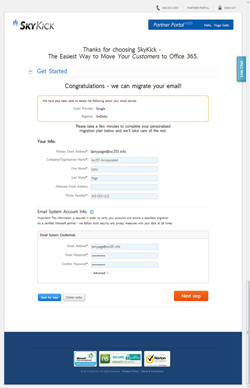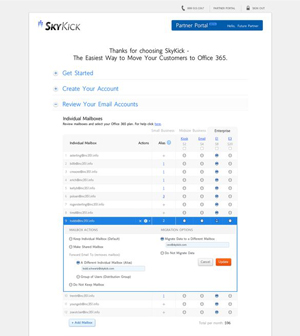In-Depth
Kicking Off a Simpler Era in Office 365 Migrations?
WEB EXCLUSIVE: Ex-Microsofties' startup called SkyKick automates the process for partners to sell, plan, provision, migrate, manage and set up Office 365.
- By Scott Bekker
- April 25, 2013
Joe Foos describes selling Office 365 as occasionally "gory."
Foos is director of sales and marketing at Lanlogic, a Bay Area Microsoft partner that has been selling Microsoft's cloud productivity suite since the Business Productivity Online Suite (BPOS) days and has earned its way into Microsoft's exclusive Cloud Champions Club.
"Selling Office 365 was always a challenge from the perspective that customers always assumed that it was an easy, button-click process to migrate data to the Microsoft cloud. It took a lot of effort, pretty much every time, to explain to folks that it wasn't as easy as Microsoft's advertising made it seem to be," Foos said. "Even with the Microsoft tool, it was still a pretty gory process."
Lanlogic is an early adopter of a new comprehensive toolset by a 2011 startup called SkyKick founded by ex-Microsofties and co-CEOs Evan Richman and Todd Schwartz. The toolset, which became generally available this week, is intended for Microsoft partners and automates five stages of Office 365 migrations -- from selling/planning to provisioning to migrating to managing to set up. Richman and Schwartz characterize their suite as a new category: migration project automation.
 "Our margins are good, customers are happy, there's less work for us, there's less work for them and it's a much faster sales cycle."
"Our margins are good, customers are happy, there's less work for us, there's less work for them and it's a much faster sales cycle."
Joe Foos, director of sales and marketing, Lanlogic.
"On average, a typical 25-user project includes five major phases, involving hundreds of tasks, 40 hours of effort, and can take from two to six weeks to complete," said Richman, describing the current Office 365 migration process that SkyKick is looking to replace.
SkyKick, which developed the SkyKick Application Suite over two years with the help of a lengthy beta program involving partners and customers, breaks out that 40 hours of effort in an Office 365 migration, as follows (based on experience and interviews with partners):
- Sales, assessment, statement of work = 4 hours
- Hoster and domain registrar discovery = 2 hours
- Mailbox, alias and distribution group discovery = 2 hours
- Email architecture planning = 6 hours
- Office 365 account/user provisioning = 4 hours
- Client-side (POP/IMAP) migration/PC = 1 hour per PC
- Server-side (POP/IMAP/Exchange) migration, quality assurance = 8 hours
- DNS changes, quality assurance = 1 hour
- Project management = 3 hours
- Company/end-user communications = 4 hours
- Outlook setup = 6 hours
SkyKick's pitch is that most of the current crop of Office 365 migration tools deal primarily with the server-side migration portion of the job. While that's the largest single time-consumer even in SkyKick's model, it's only about 20 percent of the overall migration process.
SkyKick's suite consists of four components -- a Web Planner for sales and provisioning; a Migration Sync tool for the heavy lifting of moving mailboxes, data and domains from servers or hosters into Office 365; an Outlook Assistant for each end user; and a portal for project management, communications and reporting.
In a walkthrough with RCP, Schwartz and Richman demonstrated how partners work through the steps. Using the Web Planner while sitting next to a customer or while talking on the phone, a partner can quickly assess the scope of the project and provide a reliable quote. In that new order process, the partner collects the e-mail address of the customer executive they're working with, the total number of mailboxes to migrate and the date of the migration.
The Web Planner immediately determines, just from the e-mail address, the current e-mail provider, be it an Exchange Server or any of thousands of hosters such as Google Mail. The Planner also shows the customer's domain registrar.

[Click on image for larger view.] |
| As the partner begins the Office 365 conversation with a customer, SkyKick immediately reports the e-mail provider and domain registrar based only on the customer's e-mail address. |
For the next step, SkyKick needs to collect that customer's e-mail password, from which SkyKick is able to collect all the e-mail addresses the customer has in the existing system. Schwartz emphasized that the customer doesn't need to be an admin, and said "lots of patents" are involved in SkyKick's discovery process.
From there, the partner and customer go through a list, e-mail account by e-mail account, to determine which accounts need to be upgraded and to what level. For example, in an Office 365 Enterprise setting, accounts options are shown with their monthly mailbox price -- $2 for Kiosk, $4 for Email, $8 for E1 and $20 for E3. Logic built into the Planner also prevents partners and customers from making mistakes navigating Microsoft's often confusing Office 365 rules.

[Click on image for larger view.] |
| With one user's password, SkyKick gathers e-mail information on all users in the organization. Partner and customer then go through and decide which users will get which kinds of Office 365 accounts. The pop-up box, called Fancy Mode, supports more complicated migration scenarios. |
Meanwhile, a Fancy Mode replaces scripting with checkbox options for more complicated situations, such as killing a mailbox but migrating its data to another user or forwarding mail from one user account to another.
Once the customer and partner have together determined which users will get what kind of account, the Planner generates a purchase agreement, with both a one-time migration fee and the recurring monthly cost for Office 365. On the same Web page, the customer can enter credit card information and complete the process.
"We want to empower partners to be transactional when it comes to this," Richman said.
Further steps involve sending a notification to users to hit a SkyKick page where they enter their passwords, which are required to perform the migration, and download the lightweight Outlook Assistant client. In the meantime, the Migration Sync tool synchronizes the server or hosted data ahead of the scheduled migration cutover time. When h-hour hits, SkyKick performs the DNS synchronization, the Outlook Assistant finishes things on the client side and users are theoretically ready to work inside Office 365.
Partners can monitor customers' progress on the portal. One view shows all of a partner's customer accounts, while a drill-down into individual customers shows which specific users have provided their passwords, downloaded the SkyKick Assistant, had their data synched and are finished with their migration.
After seeing the demo himself, Lanlogic's Foos was impressed but not convinced. "When SkyKick was introduced to us a year ago, it sounded too good to be true. We were very skeptical," he said.
As a beta tester partner, Lanlogic has done more than a dozen customer migrations with SkyKick. "We're really pleased with it because it does save a ton of time, it really does automate a lot of the project tasks. It really makes the customer understand a lot more about how they need to be more involved, more aware, every step of the way," Foos said.
Ted Johnson, a field engineer with Lanlogic, supports SkyKick's time estimates. "It goes from 40-plus hours of work to two or three hours of work over a week or two," Johnson said. "It takes a tedious, sometimes mind-numbing chore and turns it into a punch list of things that I need to do and that I can follow up with the client contact. It makes us look like heroes with SkyKick doing the work in the background."
To protect partners' pricing options, Schwartz won't discuss SkyKick's per-user migration pricing, but describes it as very reasonable and also notes that SkyKick leaves all Partner-of-Record fees to partners. Foos confirms Schwartz' characterization on pricing.
"We price every customer's migration as a project. In the past it would take us forever to price the darn thing. With this solution, it's about 25 percent of what we used to charge for the exact same thing and our margin is still really, really good," Foos said. "Our margins are good, customers are happy, there's less work for us, there's less work for them and it's a much faster sales cycle."